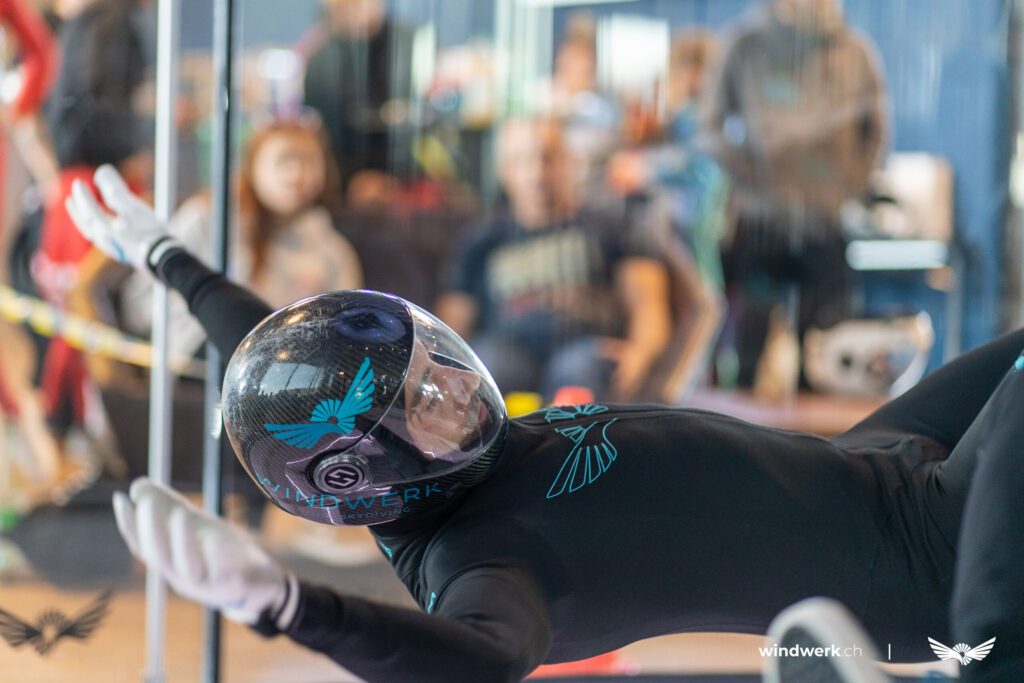
We are often asked how to become a professional pilot. If you want to fly like a pro with us, we can train you in our Flight School – provided you are at least five years old. The training program starts with the basics. In four training blocks of 15 minutes each, you will learn to fly on your stomach in all directions and do your first exercises for flying on your back. We will provide you with all the equipment you need (suit, helmet and goggles) and the combined experience of our instructors. In addition to dry training, the flights will be reviewed using video recordings and you will receive a flight logbook. The aim of the training is to enable you to fly safely and independently in our wind tunnel. Once you have mastered these skills, you will be awarded professional flyer status. We recommend that you book a maximum of two levels per day, as the flights are strenuous, especially at the beginning.
Advantages as a Proflyer
- Benefit from lower fares after Flight School (10 minutes from CHF 115).
- Fly with other sport pilots in the wind tunnel at the same time and multiply your flight time.
- Take part in our skills and tunnel camps.
Book Flight School now!
How to continue as a Proflyer?
Fortunately, no professional flyer has yet fallen from the sky, so the next step is to practise, practise, practise. We offer you various training options. At the skills camps you train with at least one professional flyer at the same time and thus multiply your flying time. The focus here is on being together and having fun. At our tunnel camps you train with the world’s best tunnel coaches. An ideal opportunity to take your skills to the next level. You can book a windwork instructor for personal coaching at any time during your flight. During the briefing, you will define the main points that you will train in the wind tunnel afterwards and take another close look at everything in the video analysis.
It gets really exciting when you start training the different disciplines and find your favorite discipline(s). Because of course you don’t just fly on your stomach.
The diversity of flying
Indoor skydiving is a sport that is practiced at wind speeds of up to 280 km/h. There are the disciplines of formation skydiving, vertical formation skydiving, freestyle and dynamic flying.
Formation skydiving involves the precise execution of formation holds in the correct sequence within a specified time (35 s).
- Number of flyers: teams of 4 or 8
- Flying position: Belly
- Wind speed: Low speed
The same applies to vertical formation skydiving, but the body is in a vertical position.
- Number of flyers: teams of 2 or 4
- Flight position: Static head-up and head-down elements with transitions
- Wind speed: High Speed
In freestyle, a self-composed choreography (freeroutine) must be performed within 75 to 90 seconds as well as a compulsory routine (45 s). A challenging discipline in which everyone can give free rein to their creativity.
- Number of flyers: Single discipline
- Flying position: belly, back, head-up and head-down as well as artistic figures and transitions
- Wind speed: Medium/High Speed
There are two variants of dynamic flying. In the Speed Routine, three flight sequences are repeated with the aim of completing them as quickly as possible. In the Free Routine variant, the team has a free choice of flight and line. Technical difficulty, variation, flow and entertainment are taken into account in the evaluation.
- Number of flyers: teams of 2 or 4
- Flight position: dynamic head-up and head-down elements
- Wind speed: High Speed
You can also find videos on the individual disciplines here on our website. If you feel really fit in one or more disciplines, you can take part in national and international competitions.
Are you motivated and want to compete with others? We are happy to support you and your team with questions or uncertainties on various topics:
- Applicable regulations for the various flying disciplines.
- How to find and select the ideal coach.
- What support is available from Windwerk and the association (Swiss Skydive).
- How and where to find suitable team partners.
We look forward to hearing from you.













